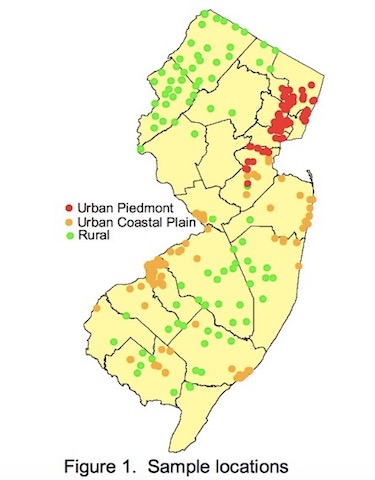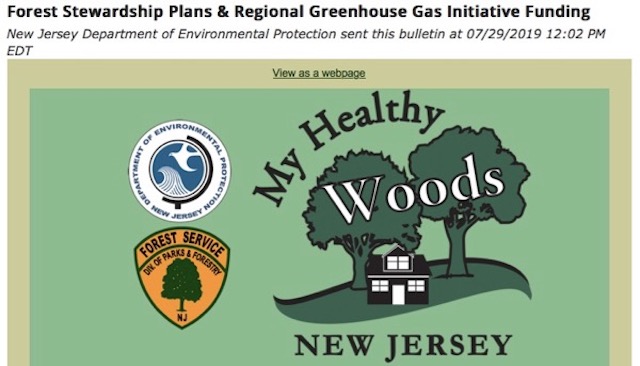Rutgers Vice Chancellor Downplays Risks Of Newark Lead Crisis – Ignores Science and Role of Race
DEP Study Shows Level of Lead In Urban Soils Far Higher Than Rural Levels
Elevated children’s blood lead & urban soil levels examples of institutional racism
Cowardice in high places
I was outraged by comments by Dr. Denise Rodgers, Vice Chancellor at Rutgers Biomedical and Health Sciences and Chair at the Robert Wood Johnson Medical School quoted in today’s NJ Spotlight story:
In addition, the doctors noted that lead has long existed naturally in the air and soil in amounts that healthy bodies can shed, but high levels of the metal — which was once added to gasoline and is common in many industrial processes — are hard for most people to process. “We’ve had lead in our environment for millennia and not everybody has terrible things happen to them because of lead,” Rodgers said.
I am outraged for several reasons:
First, that “millennia” comment is equivalent to the climate deniers who claim that we’ve always had climate change. That denial claim is technically correct, but totally misleading because it ignores the incredible rate of change we are now experiencing and the fact that the cause of the change is human industrial emissions, not natural fluctuations over geological time.
Like the atmosphere & climate change, blood lead levels and health impacts have a similar rate function – the body is exposed to and excretes lead at different rates and there is a half-life of lead in the blood (estimated as 28 days in adults).
[Update: here is the federal Centers For Disease Control (CDC) on this issue:
Lead is a relatively corrosion-resistant, dense, ductile, and malleable metal that has been used by humans for at least 5,000 years. During this time, lead production has increased from an estimated 10 tons per year to 1,000,000 tons per year, accompanying population and economic growth (4). The estimated average BLL for Native Americans before European settlement in the Americas was calculated as 0.016 μg/dL (5). During 1999–2004, the estimated average BLL was 1.9 μg/dL for the noninstitutionalized population aged 1–5 years in the United States (6), approximately 100 times higher than ancient background levels, indicating that substantial sources of lead exposure exist in the environment. ~~~ end update]
Rodgers’ use of a phrase like “terrible things” is unprofessional, unscientific, and grossly insensitive.
Since it is not a direct quote, I will not respond to the deeply troubling claim that” healthy bodies can shed (low naturally occurring levels of) lead“.
Second, Rodgers’ comment also shows an ignorance of the actual “natural background” lead levels in New Jersey soils and their regional distribution.
NJ DEP has characterized, among other, the “natural background” levels and distribution of lead in NJ soils:
Current New Jersey law requires that the NJDEP determine background levels of contaminants in soils and that “Remediation [of contaminated areas] shall not be required below regional natural background levels for any particular contaminant” [N.J.S.A. 58:10B-12(g)(4)]. “Natural background level” is further defined as “…the concentration of a contaminant consistently present in the environment of the region of the site and which has not been influenced by localized human activities….”
Here’s what DEP found, see: Ambient Levels of Metals in New Jersey Soil (2003):
Between 1996 and 2001, three studies were conducted to determine the ambient levels of extractable metals in New Jersey soils. These studies were conducted to gather information to support the development of soil cleanup criteria, which cannot be set below ambient levels. A total of 248 soil samples were taken from the urban Piedmont region, the urban Coastal Plain region, and rural regions of the Valley and Ridge, Highlands, and Coastal Plain provinces.
That DEP study found that lead levels in urban areas are far higher than in rural areas:
A single rural soil sample yielded a beryllium concentration slightly above the corresponding criterion. For the urban Coastal Plain study, three of the 91 samples contained levels of arsenic above the current criterion. The urban Piedmont study yielded eight samples out of 67 where levels of arsenic or lead exceeded the criteria.
The urban median soil lead concentration was 111 mg/kg (ppm), with a 90th percentile concentration of 257, while the rural media was just 31.6 and 90th percentile 54 (see Table 1). (Context: the DEP residential soil cleanup standard is an astronomical 400 ppm)
So, in addition to the childhood blood lead levels, the levels of lead in soil are far higher in urban NJ – and urban NJ is where the garbage incinerators, a major source of lead emissions, are located. These are additional factors in the larger environmental justice crisis.
Rodgers also ignores the racial dimension of the problem, by attributing the “root cause” exclusively to poverty, thereby denying abundant evidence of disproportionate burdens that are highly correlated with race and the large body of literature on environmental injustice:
“Let’s also talk about the root cause, which is all these children living in poverty,” Rodgers added. Not only are poor children more likely to live in older houses that could be contaminated by lead paint, she said, but their families also don’t have the resources to remediate the problem in the way that more affluent residents do.
At the end of today’s NJ Spotlight story – which clearly was a shameful effort to downplay risks and provide cover for negligent government officials under the arrogant and paternalistic guise of preventing “panic” – there are closing paragraphs under the heading “This is not like Flint”.
The story correctly distinguishes the drinking water risks between Flint and Newark, but ignores the deep racist environmental injustice and the shared failed regulatory framework and negligent oversight by federal, state and local officials.
The later amounts to institutional racism. Period.
Ignoring the role of government officials is significant. Recall that officials responsible for Flint disaster faced criminal charges. But unlike Flint, which was an emergent problem, NJ is far worse: NJ officials have known about lead problems for years, see:
In conclusion, after ignoring race, environmental injustice, a fatally flawed regulatory framework, the negligence of government officials, workplace exposures, other major lead sources, and the political power of polluters who have captured the regulators, those “experts” then proceed to essentially blame the victims and tell them to change their work clothes, dust their windowsills, and wash their hands!
Residents are urged to contact the New Jersey poison center (1-800-222-1222) for more information on prevention — including tips on how to protect against carrying contamination into the home from a parent’s workplace — and for help interpreting the results of a blood-lead level test, Calello said. They are also urged to watch for peeling paint, wipe up dust in areas where children play, especially along the windowsills of older houses, and wash their hands and their children’s hands frequently.
Shame on them all.
[End Note: DEP conducted a study on the health risks and impacts of importing contaminated soil to the Martin Luther King, Jr. school construction site in Trenton. That study found astronomically high lead levels in indoor dust on the window sills of nearby homes (3,000 ppm).
Remarkably, the DEP has since seemed to have deleted the lead dust swipe sampling data tables (see pages 63 and 90) so I can’t correctly cite the data!
DEP’s study determined that the source of the lead did not come from the school construction site and did nothing to remediate the indoor dust.
The concentration of lead across the residences was highly variable without a clear spatial pattern indicating that the soil at the construction site was not the primary source of lead for the dust around residences, but rather that lead came from leaded paint existing at the residences or from historical lead deposited in the soil from leaded gasoline used decades ago. …
The levels measured around the residences are generally higher than the levels in the soil or concrete aggregate samples on site. That, combined with the high variability suggests highly localized sources around many of the residence, most likely from old exterior leaded paint on the windows. There may also be some contribution from soil previously contaminated with leaded gasoline. This is common for an area containing pre-World War II homes of the age of this community. Thus, the transport of soil and dust from the site during construction was not a major source of lead to the community. …
Conclusions
There was evidence that soil and concrete aggregate material spread off the construction site affecting, on average, the levels of dust outside homes within one block of the site, but not inside these homes. Thus, individuals who were outside their homes during the construction would have been exposed to those materials. The lead levels in dust collected inside and outside homes are apparently related to local sources rather than offsite soil or dust transport from the school construction site.
At the time, DEP only issued a dust control directive to the School Construction Corporation folks and issued a press release, but did nothing to remediate the lead risk and warn the residents.
After my public criticism, (see also “Calling Out Scott Weiner On School Reforms“), DEP sent a letter 4 years after the study (it is unclear exactly when DEP issued a Citizens Guide
This is another example of grossly negligent oversight, fatally flawed regulations, and environmental injustice.
There also was another example of blatant abuse in Camden, see:
~~~ end]

